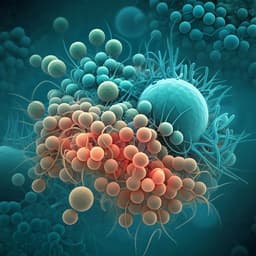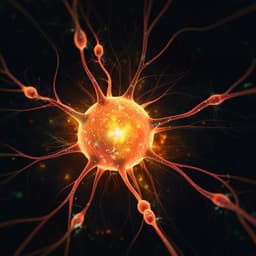
Medicine and Health
A single-cell transcriptomic atlas of exercise-induced anti-inflammatory and geroprotective effects across the body
S. Sun, S. Ma, et al.
This groundbreaking study reveals the powerful effects of long-term aerobic exercise on both physical function and gene expression in young and aged male C57BL/6J mice. The research, conducted by esteemed authors including Shuhui Sun and Shuai Ma, highlights the broad health benefits of exercise, uncovering BMAL1 as a key player in reversing aging-related gene changes and enhancing resilience against infections.
~3 min • Beginner • English
Introduction
The study investigates how long-term exercise modulates molecular programs across multiple tissues and ages, addressing two central questions: how tissues and organs coordinate at a whole-body level to mediate exercise benefits, and whether exercise exerts similar protective and geroprotective effects in young versus aged individuals. Prior research has largely focused on skeletal muscle, leaving systemic, non-muscle tissue responses poorly understood. The authors hypothesize that exercise induces systemic, tissue- and cell type-specific transcriptional reprogramming, with potential age-dependent differences, that underlies anti-inflammatory protection and geroprotection. They aim to map these effects at single-cell resolution across the body in young and old mice, and to identify key regulatory mechanisms mediating the benefits of exercise, particularly in response to acute inflammatory challenge and aging.
Literature Review
Existing literature establishes that exercise yields broad health benefits, improves neuroplasticity and cognition, and impacts diverse organ systems beyond muscle. Canonical exercise-induced pathways include IGF1/PI3K/Akt, AMPK, mTOR, and PGC-1α. Aging studies using single-cell approaches and systemic interventions (e.g., caloric restriction, heterochronic parabiosis) have revealed widespread cellular and molecular remodeling with age. However, systemic single-cell atlases capturing exercise effects across multiple tissues, and particularly age-specific differences, have been lacking. Prior studies suggest exercise’s anti-inflammatory roles and benefits to nervous and cardiovascular systems, but the molecular coordination across tissues and roles of circadian regulation in exercise-mediated aging resistance remain to be elucidated.
Methodology
- Animal model: Male C57BL/6J mice, young (2 months) and old (16 months) at baseline.
- Intervention: Up to 12 months of voluntary wheel running (Y-Ex, O-Ex) versus standard housing controls (Y-Ctrl, O-Ctrl). Real-time wheel activity recorded.
- Phenotyping: Body weight, metabolic cage readouts, composite physical score, rotarod, grip strength, treadmill endurance, Y-maze (spatial learning/memory), plasma IL-1β, AST/ALT ratio.
- Bulk RNA-seq: 13 tissues (brain, spinal cord, skeletal muscle, heart, lung, aorta, kidney, liver, small intestine, testis, spleen, bone marrow, peripheral blood) from all groups. PCA to assess age and exercise segregation of tissue transcriptomes.
- Single-cell profiling: scRNA-seq for lung, aorta, kidney, liver, small intestine, testis, spleen, bone marrow, peripheral blood; snRNA-seq for brain, cerebellum, spinal cord, heart, skeletal muscle. Quality control yielded 507,636 high-quality transcriptomes across 14 tissues.
- Cell type identification: 305 clusters assigned to 101 major cell types; included tissue-specific parenchymal cells and shared stromal and immune subsets. Immune cells further resolved into 27 subtypes.
- Differential expression analyses: Defined YE DEGs (Y-Ex vs Y-Ctrl) and OE DEGs (O-Ex vs O-Ctrl) per tissue/cell type. Functional enrichment via GO/pathways. Mitochondrial and AMPK gene sets examined. Identified age-dependent and tissue-specific responses.
- Acute inflammation challenge: After the 12-month period, subsets of mice received intraperitoneal LPS to induce systemic inflammation. Tissues profiled (sc/snRNA-seq and bulk RNA-seq): liver, lung, aorta, bone marrow, peripheral blood. Defined Rev-LPS DEGs (LPS-induced changes reversed by exercise) and computed Rev-LPS/LPS DEG ratios per cell type/tissue and age.
- Aging reversal analysis: Identified Aging DEGs (O-Ctrl vs Y-Ctrl). In old exercised mice (O-Ex vs O-Ctrl), partitioned aging DEGs into Pro-aging (same direction) and Rev-aging (opposite direction). Calculated rescued ratios per tissue/cell type. Assessed intercellular communication changes via ligand-receptor inference.
- Transcriptional network and circadian analysis: Used SCENIC to infer TF regulons impacted by aging and exercise. Cross-referenced sc/snRNA-seq with bulk RNA-seq to identify robust tissue-level changes. Tallied high-frequency DEGs across cell types/tissues. Focused on circadian clock components (BMAL1/Clock positive loop; Dbp, Nr1d1/2, Per2 negative loop).
- Histology and ultrastructure: WGA staining for muscle fiber cross-sectional area; EM for mitochondrial content (skeletal muscle, heart); neuronal counts (ChAT+ motor neurons), neurofilament at NMJs; cortical thickness (NeuN staining); immune infiltration markers (CD45, neutrophils, F4/80); TUNEL; IL-1β IHC; senescence markers (SA-β-gal, p21); fibrosis and lipid droplets; GLUT-1 for BBB/BSCB integrity; organ-specific morphometrics.
- Endothelial cell mechanistic assays: Cardiac arterial endothelial cells (CAECs) RNA-ISH for Bmal1; primary CAEC senescence model; CRISPR-Cas9 Bmal1 knockdown and lentiviral BMAL1 overexpression; assays for SA-β-gal, p16/p21 expression, monocyte adhesion, VCAM-1/ICAM-1/Il1b expression, IL-6 secretion (ELISA), proliferation (Ki67), migration (scratch assay), tube formation. Tested protection against LPS in vitro. Also assessed BMAL1 deficiency effects in cardiomyocytes.
- Statistics: DEG identification across datasets; enrichment analyses; visualization via t-SNE/heatmaps/network plots; group comparisons via two-tailed Student’s t tests for quantified histological/cellular assays.
Key Findings
- Behavioral and physiological effects: After 12 months, both young and old exercised mice had lower body weight, higher physical scores, improved motor coordination/endurance (rotarod, treadmill), increased grip strength, and aged mice showed improved Y-maze performance. Plasma IL-1β reduced in aged exercised mice; age-associated increase in AST/ALT ratio suppressed by exercise.
- Single-cell atlas: 507,636 single-cell/nucleus transcriptomes across 14 tissues resolved into 305 clusters and 101 cell types, including broad stromal and immune populations detected across organs.
- Age-dependent transcriptional reprogramming: Exercise-induced DEGs (YE vs OE) were largely distinct and tissue-specific. Young tissues like kidney, small intestine, aorta, and testis showed greater responsiveness (e.g., ECs, SMCs, macrophages in kidney), while aged nervous system tissues (brain, cerebellum, spinal cord) were more responsive in older mice (ECs, pericytes, neurons, Purkinje and granule cells). In young mice, exercise downregulated immune activation and cell death pathways broadly; in aged mice, exercise upregulated neural functional pathways in CNS tissues. Mitochondrial and AMPK-related genes were activated in young kidney/aorta and aged nervous system, with convergent upregulation in heart and skeletal muscle in both ages. Hematopoietic tissues (bone marrow, blood, spleen) showed modest changes.
- Phenotypic correlates: Exercise increased muscle fiber cross-sectional area and intermyofibrillar mitochondria in skeletal muscle and increased interfibrillar mitochondrial area in heart (EM). It increased motor neuron numbers and neurofilament density at NMJs and thickened cerebral cortex in both age groups.
- Protection against acute inflammation: Exercise preconditioning strongly mitigated LPS-induced transcriptional changes in young mice, notably in hepatocytes, ECs, Kupffer cells (liver) and multiple immune cells (lung). Rev-LPS/LPS DEG ratios were high in young mice and much lower in old mice. Exercise dampened classic LPS-responsive genes (e.g., Gbp2, Arid5a, Hmgb1/2) and pro-inflammatory/apoptotic pathways (NF-κB, MAPK, complement/coagulation, NOD-like receptor, chemokine signaling, neutrophil degranulation). Transcriptional activation of Hif1a, Stat2/3, Cebpb, Arid5a networks by LPS was abolished in young exercised mice. Histologically, exercise reduced LPS-induced infiltration of CD45+ cells, neutrophils, and F4/80+ macrophages, decreased IL-1β expression and apoptosis in liver, and attenuated ALT elevation and lung edema.
- Reversal of aging signatures: Across tissues, Rev-aging DEGs outnumbered Pro-aging DEGs, indicating broad rejuvenation. The strongest rescue occurred in aged CNS (spinal cord, brain, cerebellum). High rescued ratios were seen in ependymal, meningeal cells, pericytes, oligodendrocytes, ECs (spinal cord), astrocytes and excitatory neurons (brain), as well as myofibers (skeletal muscle) and cardiac fibroblasts/pericytes. ECs across multiple tissues and CD8+ T cell subsets showed consistent rescue. Upregulated Rev-aging DEGs enriched for morphogenesis, vasculature development, Wnt, and neurogenesis/synaptic pathways; downregulated Rev-aging DEGs enriched for inflammation and apoptosis. Exercise also reset age-dysregulated intercellular communication (e.g., reduced VCAM-1 and ICAM-1 mediated leukocyte-EC interactions).
- Anti-inflammatory and geroprotective phenotypes: Exercise reduced microglial (IBA1+) and astrocytic (GFAP+) activation across CNS regions; decreased CD45+ immune infiltration and neutrophils in liver/lung/kidney; lowered IL-1β in liver/kidney; reduced senescence markers (SA-β-gal, p21), fibrosis (liver/lung/spleen), and hepatic lipid droplets; restored GLUT-1 expression (BBB/BSCB integrity); improved organ histometrics; and replenished type IIA fast fibers in aged skeletal muscle.
- Circadian reprogramming as a core mechanism: SCENIC identified circadian TFs (Dbp, Tef, Nr1d1, Nr1d2, Bhlhe41) dysregulated with aging but restored by exercise. Bmal1 (Arntl) and Dbp were robust Rev-aging DEGs at bulk and single-cell levels and were rescued in over 30 cell types. Exercise restored circadian clock components with tissue-specific patterns: reactivating positive loop (Bmal1) and dampening overactive negative loop (Dbp/Nr1d1/2), varying by tissue (heart/muscle/spinal cord vs aorta/intestine/kidney/lung/liver). ECs showed especially strong restoration of rhythmic indices.
- BMAL1 as mediator of geroprotection: In CAECs, Bmal1 mRNA declined with aging and was restored by exercise. Senescent CAECs had reduced BMAL1. Bmal1 knockdown accelerated senescence (↑SA-β-gal, p16, p21), increased monocyte adhesion and EC dysfunction markers (VCAM-1, ICAM-1, Il1b). BMAL1 overexpression reduced senescence and inflammatory markers, decreased IL-6 secretion, and enhanced proliferation, migration, and tube formation; it protected against LPS-induced EC dysfunction. In aged hearts, exercise increased CD31+ ECs and reduced VCAM-1+ ECs, aligning with vasoprotective effects downstream of BMAL1.
Discussion
The study addresses how exercise orchestrates whole-body adaptations by resolving transcriptional responses at single-cell resolution across 14 tissues in young and aged mice. Findings demonstrate that exercise confers strong anti-inflammatory protection against acute systemic inflammation predominantly in young animals, while in aged animals it broadly reverses aging-associated transcriptional programs and phenotypes, with especially pronounced effects in the nervous system and endothelial compartments. These results reconcile age-specific benefits: acute injury protection is more robust in youth, whereas long-term geroprotective remodeling is evident with exercise in older age. A central insight is that long-term exercise resets dysregulated circadian programs across tissues, with BMAL1 emerging as a key mediator. Restoration of BMAL1-driven rhythmic regulation in ECs and other cell types links exercise to reduced vascular inflammation, improved angiogenic capacity, and systemic rejuvenation. These mechanisms offer a unifying framework connecting exercise, circadian homeostasis, inflammation control, and tissue regeneration, providing targets for exercise-mimetic strategies against age-related degeneration and chronic disease.
Conclusion
This work delivers a comprehensive single-cell atlas of exercise-induced molecular and cellular adaptations across 14 tissues, revealing age-dependent, tissue- and cell type-specific reprogramming. Exercise robustly protects young mice from acute inflammatory injury and reverses aging-associated transcriptional and phenotypic alterations across multiple organs in older mice. A major mechanistic axis uncovered is circadian clock resetting, with BMAL1 serving as a central effector mediating vasoprotective, anti-inflammatory, and pro-regenerative effects, particularly in endothelial cells. These findings broaden understanding of the systemic benefits of exercise and lay a foundation for developing therapeutic interventions and exercise mimetics that target circadian and inflammatory pathways to promote healthy aging. Future work should test causality and sufficiency of clock components in vivo across tissues, extend analyses to females and diverse exercise modalities/intensities, and translate to human tissues and clinical outcomes.
Limitations
- Sex limitation: Only male mice were studied; sex-specific responses to exercise and circadian reprogramming remain to be determined.
- Exercise modality and dose: Voluntary running introduces variability in intensity and duration; other exercise types (resistance, interval) were not examined.
- Species and translatability: Mouse findings require validation in humans; tissue-specific responses may differ across species.
- Acute inflammation model: LPS is a surrogate for bacterial sepsis and may not capture all features of clinical infections.
- Causality at organismal level: While BMAL1 was mechanistically validated in endothelial cells and cardiomyocytes in vitro (and partially in vivo by expression analyses), systemic causality across tissues and cell types was not comprehensively tested via tissue-specific genetic models.
- Hematopoietic tissues: Bone marrow/blood showed limited DEGs, possibly reflecting lower responsiveness or sensitivity of the profiling approach.
- Temporal resolution: End-point profiling after long-term exercise does not capture dynamic adaptation trajectories or circadian phase-dependent effects.
Related Publications
Explore these studies to deepen your understanding of the subject.







